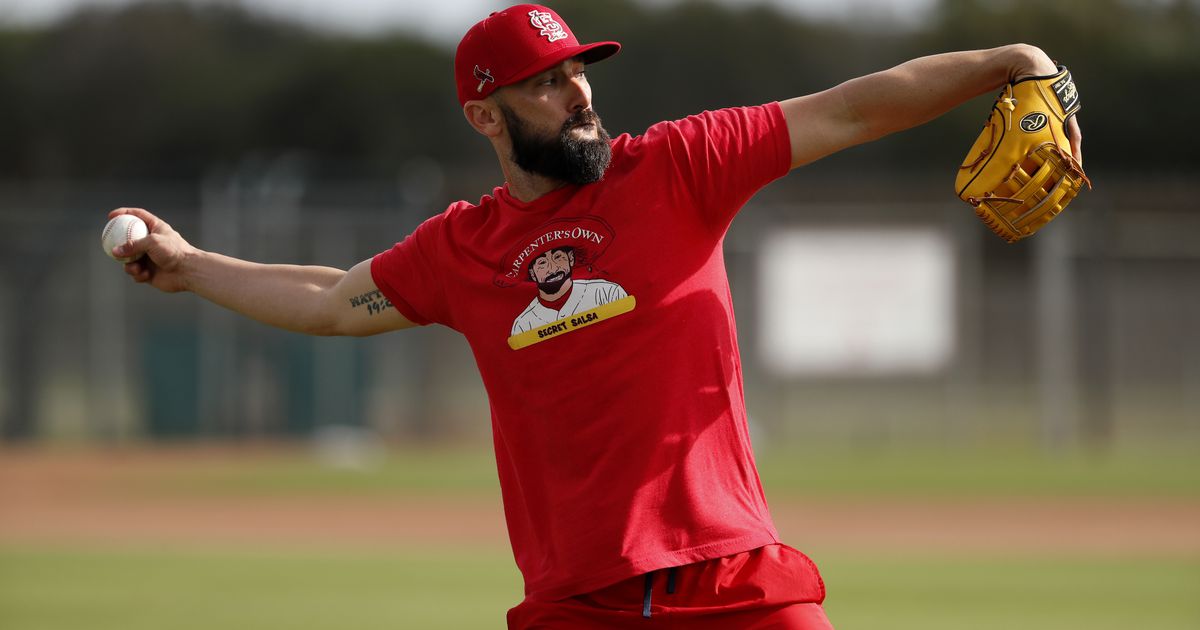Cards spring training by the numbers as pitchers and catchers report


While the 2021 MLB season figures to be more normal than the truncated 2020 campaign, much is still out of the ordinary as spring training begins and the COVID-19 pandemic continues to affect everyday life.
The St. Louis Cardinals’ preparations for the season officially get underway Wednesday as pitchers and catchers report to camp in Jupiter, Florida. And while the acquisition of five-time All-Star Nolan Arenado and the return of club icons Yadier Molina and Adam Wainwright have created considerable excitement about the club’s chances to take a step forward in 2021, the realities of the pandemic remain. A significant priority this season will be health and safety as the team looks to avoid being sidelined by a COVID-19 outbreak for a second season in a row.
And so begins a spring training that’s normal in some ways and unprecedented in many others. Let’s take a look, by the numbers.
ZERO: Players in minor league camp.
In order to facilitate social distancing, minor league players without invitations to major league camp will not report to spring training until after big league camp breaks at the end of March. In past years, teams have often supplemented their spring training rosters with minor leaguers called up from the back fields — position players to serve as late-inning defensive replacements and extra arms in case the pitchers from big league camp exceed their pitch counts or sustain injuries. With safety taking precedence this spring, fewer players will receive opportunities to prove themselves in major league exhibition games.
THREE: Players on the 40-man roster who are out of minor league options for the first time in 2021.
It’s an especially important spring for right-hander Daniel Ponce de Leon, infielder Edmundo Sosa and outfielder Justin Williams. All three are out of options and will need to make the Cardinals‘ 26-man Opening Day roster, begin the season on the injured list or be exposed to waivers and removed from the 40-man roster. It’s possible, however, that Williams will be granted a rare fourth option based on a stipulation to the rules entitling a player to an extra option year if he exhausts his standard three options before reaching five qualified professional seasons. A player generally is required to spend 90 days on an active roster to qualify for a season of service time, so if MLB decides that the abbreviated 2020 campaign doesn’t count as a qualified season, Williams could earn an extra option.
FOUR: Spring training opponents.
With MLB looking to reduce travel this spring in the Grapefruit League, where teams’ facilities are spread all over Florida, the Cardinals will play only the four teams that train on the state’s Atlantic coast. They’ll play six games each against the Astros, Marlins, Mets and Nationals. Though there’s technically an even split of home and road games, they’ll play 15 games at their home facility since they share it with the Marlins.
FIVE: Positions at which Matt Carpenter has appeared in his major league career.
Carpenter has been a fixture in the Cardinals’ lineup for the last eight seasons, but he’ll transition to a bench role in 2021 with Nolan Arenado taking over as the everyday third baseman. While Carpenter has spent most of his major league career at the hot corner, he was the Cards’ primary starter at second base in 2013 and at first base in 2017. He also spent some time at the corner outfield spots during the early part of his career, and while his range might not be what it once was at 35 years old, his history of versatility is likely to come into play this season. With Brad Miller and Rangel Ravelo no longer in the organization, Carpenter could end up being the primary backup at first, second and third base.
EIGHT: Newcomers to the Cardinals organization in big league camp.
Arenado is, by far, the Cards’ biggest addition this offseason, but several other newcomers have a chance to impact the major league club in 2021. Catchers Tyler Heineman and Ali Sánchez figure to start the season at Triple-A Memphis but will provide depth behind Yadier Molina and Andrew Knizner. Infielders Max Moroff and José Rondón, both of whom have more than 100 games of MLB experience, should compete with Edmundo Sosa for a backup middle-infield role that could exist if the Cardinals begin the season with a five-man bench. Right-hander Johan Quezada, a recent trade acquisition who saw brief big league action for the Marlins in 2020, and lefty Garrett Williams, whom the Cards selected in the minor league phase of the Rule 5 Draft, may factor into the bullpen mix at some point this summer.
11: Cardinals spring training games in which teams will be allowed to end innings before three outs are recorded and can shorten games to five or seven innings.
Because minor league camp won’t begin until April, MLB has introduced several rules to prevent players from being overworked during the exhibition season. From the start of the spring schedule through March 13, teams will be allowed to finish innings before three outs are recorded if a pitcher has thrown at least 20 pitches. Games during that stretch can also be shortened to either five or seven innings upon mutual agreement of the managers, and games from March 14 through the end of the exhibition schedule can be reduced to a minimum of seven innings. Pitchers will be allowed to re-enter all spring games.
21: Percent capacity.
The Cardinals will play in front of fans for the first time in nearly a year when they open their spring schedule Feb. 28. Roger Dean Chevrolet Stadium, the Cards’ spring home, will be filled to 21 percent capacity with fans sitting in socially distant pods. While the crowds will be far from full, it’ll be much closer to a familiar environment for players who spent the 2020 season playing in empty stadiums.
23: Pitchers with major league experience.
A COVID-19 outbreak and a series of injuries forced the Cardinals to rely on a significant number of inexperienced pitchers in 2020, 10 of whom pitched in the big leagues for the first time. The flip side of that conundrum is that the Cards will have plenty of major league-tested pitching depth in 2021. Twenty-three of the 33 pitchers in camp have at least one game of MLB experience, though Dakota Hudson won’t pitch after undergoing Tommy John surgery last September. It’s likely that every major league club will use a lot of pitchers this season following an abbreviated 2020 campaign in which every pitcher’s workload was reduced, so it’ll be a major plus for the Cardinals to have nearly a full staff of big-league veterans waiting in Triple-A.
24: Spring training games.
The Cardinals were originally slated to play 30 spring games, but the league decided to reduce the exhibition schedule after limiting the number of players allowed to participate. Gone are split-squad games, a traditional spring staple, as teams may not be able to field two full teams in a day without the ability to call up players from minor league camp. The Cards have five off days — far more than they’d have during a typical exhibition slate.
67: Players in camp.
In addition to the 39 members of their 40-man roster, the Cardinals will bring 28 non-roster invitees to camp. There’s already one 40-man spot open if a non-roster player impresses enough to earn a spot on the Opening Day roster, and another one could be opened if the club places Hudson on the 60-day injured list.
75: Players allowed in major league spring training.
MLB’s health and safety protocols require that spring training rosters not exceed 75 players in an effort to maintain social distancing. The Cardinals are well under the limit for now, so they have room to add players via free agency, trade or waivers in the coming weeks.






